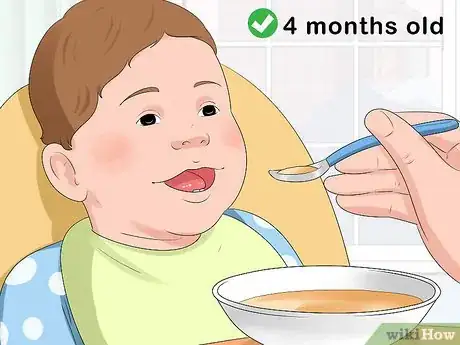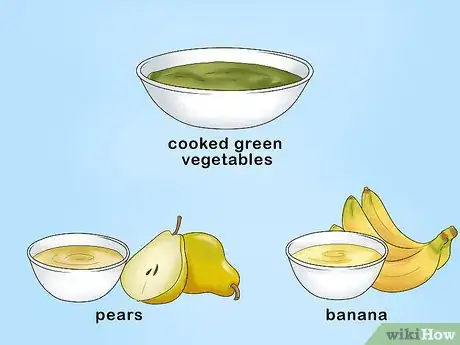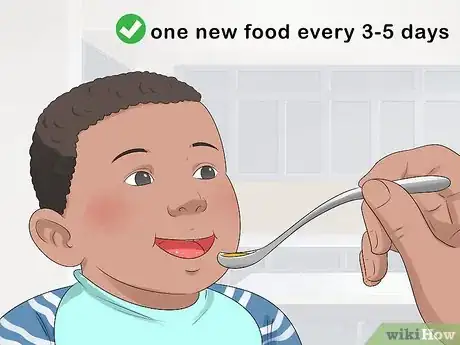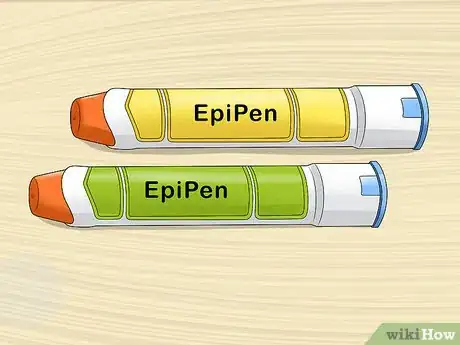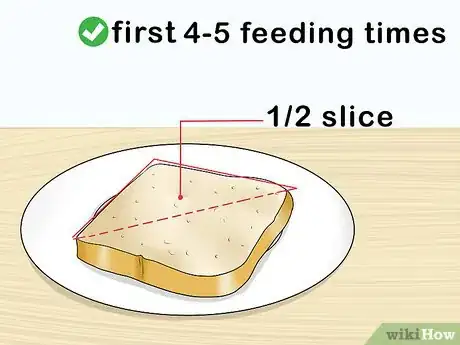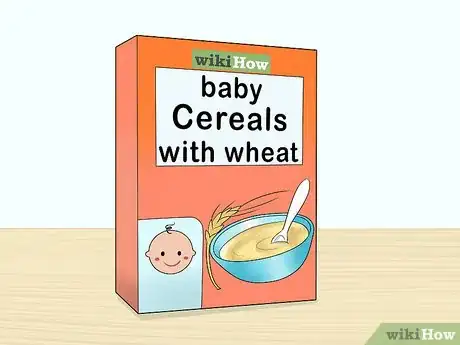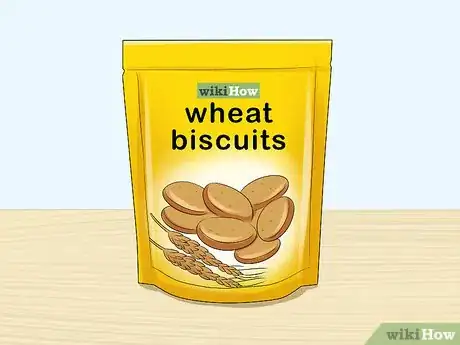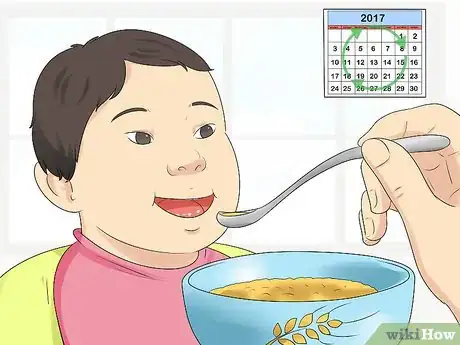This article was medically reviewed by Sarah Gehrke, RN, MS. Sarah Gehrke is a Registered Nurse and Licensed Massage Therapist in Texas. Sarah has over 10 years of experience teaching and practicing phlebotomy and intravenous (IV) therapy using physical, psychological, and emotional support. She received her Massage Therapist License from the Amarillo Massage Therapy Institute in 2008 and a M.S. in Nursing from the University of Phoenix in 2013.
There are 8 references cited in this article, which can be found at the bottom of the page.
This article has been viewed 14,508 times.
You can usually introduce your baby to wheat products and rice products along with other solids, between 4 to 7 months of age. Go slowly and give your baby a small bit of wheat toast or cereal. Then, as with any new food, watch your baby for 5 days to see how they handle it. If your baby shows no signs of an allergic reaction or sensitivity, you can start feeding them wheat foods daily. This will add valuable fiber and other nutrients into your baby’s diet.
Steps
Introducing Wheat alongside Other Solids
-
1Introduce solids at 4 months. If your child is transitioning from liquid foods to solids, then you can start feeding them wheat at this time as well. Most children start this transition between 4-7 months. Adding wheat into your baby’s diet at this point helps to give them additional calories and nutrients, such as folate.[1]
- Giving your baby potentially allergenic foods, such as wheat or eggs, early on can actually help them to avoid food allergies later on in life.
-
2Start with non-allergenic foods. Start by giving your baby single ingredient, non-allergenic foods, such as cooked green vegetables, pears, or bananas. Once your baby does well with these foods, then move on to introducing more allergenic foods, such as wheat or egg products.[2]
-
3Offer only one new food every 3-5 days. An allergic reaction or intolerance to wheat is unlikely.[3] However, giving your baby new foods one at a time will allow you to narrow down the cause of a reaction, if there is one. The 3-5 day waiting period also gives your baby’s body plenty of time to respond physically as some symptoms, like diarrhea, may not show up right away.[4]
- This is a good rule to follow with any new food, not just wheat.
-
4Keep breastfeeding if possible. As you make the transition to solid foods for your baby, try to continue breastfeeding as a supplement to this new type of food. You can also mix breastmilk into wheat products, like cereals, to make your baby enjoy them more. Breastfeeding also strengthens your baby’s immunity.[5]
- If you are not breastfeeding, you can also mix products into formula to give your baby a familiar taste.
Recognizing and Responding to Allergic Reactions
-
1Talk with your pediatrician. At your baby’s 4 or 6 month appointment, bring up the possibility of introducing wheat products into your baby’s diet. Your pediatrician will use your baby’s medical history and your background to give you advice about moving forward. Most of the time they will suggest that you just proceed as normal with intervals in between new foods.[6]
- For example, if your baby has already exhibited an allergic reaction to other grains, then your pediatrician may suggest that you wait on wheat until your baby is 1.
-
2Know the signs of an allergic reaction. When you start to introduce your baby to potentially allergenic foods, then it’s important to know what a reaction looks like so that you can respond quickly. In the rare case that your baby doesn’t tolerate wheat well, they might experience hives and swelling in the face, lip, or tongue. In very extreme cases, your baby might begin vomiting or spontaneously coughing. Breathing problems and skin itching are other serious and more rare signs.[7]
- Diarrhea is another symptom that might show up over the 1-2 days following the introduction of a new food, such as wheat. If you notice a substantial change in your baby’s stools, then you might want to delay adding wheat into their diet.
- Keep in mind that there is a big difference between a sensitivity and an allergy. Your child may only be sensitive to wheat if they have excessive gas, abdominal pain, diarrhea, or constipation.[8]
-
3Get an allergy test done if your baby has shown signs of a food allergy. Talk with your pediatrician about getting a referral to a pediatric allergist. After you talk with the specialist, they may do a contact test to see which substances your baby responds negatively to. This may help you to decide when to introduce wheat.[9]
-
4Carry an EpiPen if your child is allergic to other substances. If your baby has identified food allergies, then your pediatrician may suggest that you continue to introduce new foods, but with the EpiPen as a back-up. This device can give your child an injection of epinephrine to counteract any reaction while you seek medical assistance.[10]
Offering Tasty Wheat Foods
-
1Give your baby a small amount of wheat initially. As with any new food, it’s a good idea to feed your baby only a taste of a wheat product for the first 4-5 times. A ½ slice of wheat bread or 2-3 cooked wheat pasta pieces is a sufficient amount to test your baby’s tolerance.[11]
- If you are still breastfeeding, you can also place 2–3 tablespoons (29.6–44.4 ml) of wheat cereal into a bowl and soften it with breastmilk. Then, spoon feed this mixture to your baby.
-
2Offer your child cereal. You can find wheat or multigrain baby cereals in your grocery store. Baby cereals are a finer grain that their adult counterparts. You can also mix wheat cereal in with breastmilk or formula to make it more palatable and easier to eat for babies.[12]
- If you purchase a multigrain cereal, read the ingredients label to make sure that it includes wheat.
- You can also mix cereal in with baby food. It’s generally not a good idea to place a cereal mixture into a bottle.
-
3Mix pastina into other foods. Pastina are little bits of pasta, usually made out of wheat or multigrain. Since they are so small in size, they are a great transition food for babies making the move to solids. You can stir some pastina into pureed baby food or even into low-sodium soup.[13]
- Pastina also come in a variety of fun shapes, such as stars, to encourage your baby to eat.
-
4Offer wheat crackers or biscuits. You’ll want to get a cracker or biscuit that doesn’t contain added sugars, is made out of whole wheat, and is not too crispy for a baby new to solid foods. You may need to test out a few brands. You can also spread a very thin layer of cream cheese onto the cracker to make it more tasty.[14]
- Wheat teething biscuits can be a good option. However, check to make sure that they are not packed with sugar.
-
5Serve wheat toast. If your baby has moved on to finger foods and you still need to introduce wheat products, then try to give them a few toast bites. You can make a piece of whole wheat bread toast and then cut it into thin strips.[15]
- You can also offer a dipping sauce, such as pureed fruit baby food.
-
6Keep wheat as a part of your baby’s diet moving forward. Once you’ve introduced wheat successfully, it’s a good idea to make it a regular part of your baby’s diet. This may even make your baby less vulnerable to other potentially allergenic foods. Plus, all babies benefit from a bit of extra fiber in their system.[16]
Warnings
- Supervise your baby while they are eating. It’s always a good idea to stay close by when your baby is eating in order to watch for choking and other possible food-related issues.[17]⧼thumbs_response⧽
- If your baby has eczema, then they are more likely to experience a food allergy. Talk with your pediatrician for advice regarding introducing new foods.[18]⧼thumbs_response⧽
- If your baby shows any signs of breathing problems after eating wheat, seek emergency medical assistance right away.⧼thumbs_response⧽
References
- ↑ https://www.babycenter.com/0_introducing-solids_113.bc
- ↑ http://www.kidswithfoodallergies.org/page/introducing-solids-infants.aspx
- ↑ https://www.parents.com/baby/health/allergy/does-my-baby-have-a-gluten-allergy/
- ↑ https://www.thebump.com/a/food-allergy-baby
- ↑ https://www.babycenter.com/0_introducing-solids_113.bc
- ↑ https://www.babycenter.com/0_introducing-solids_113.bc
- ↑ https://www.thebump.com/a/food-allergy-baby
- ↑ https://www.parents.com/baby/health/allergy/does-my-baby-have-a-gluten-allergy/
- ↑ https://www.babycenter.com/0_introducing-solids_113.bc
- ↑ https://www.thebump.com/a/food-allergy-baby
- ↑ http://www.kidswithfoodallergies.org/page/introducing-solids-infants.aspx
- ↑ https://www.healthychildren.org/English/tips-tools/ask-the-pediatrician/Pages/When-should-I-introduce-wheat-into-my-babys-diet.aspx
- ↑ https://health.usnews.com/health-news/blogs/eat-run/2013/03/19/how-and-why-to-introduce-allergens-to-your-infant
- ↑ https://health.usnews.com/health-news/blogs/eat-run/2013/03/19/how-and-why-to-introduce-allergens-to-your-infant
- ↑ http://www.parents.com/recipes/baby-food/new-foods-to-feed-baby/
- ↑ https://www.allergy.org.au/patients/allergy-prevention/ascia-how-to-introduce-solid-foods-to-babies
- ↑ https://www.allergy.org.au/patients/allergy-prevention/ascia-how-to-introduce-solid-foods-to-babies
- ↑ https://www.thebump.com/a/food-allergy-baby
